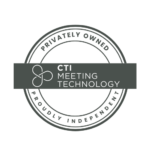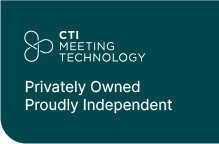Scientific conferences are a great way to gather like-minded people together to share ideas, network, and learn directly from experts in their field. Panel discussions and presentations are spaces in conferences designed to engage the audience in a conversation regarding the conclusions of a specific scientific study, listening to a group of experts share their insights. However, in events with many participants, it can be difficult to analyze the feedback or trends of the group. Furthermore, with the rise of virtual and hybrid events, event planners must come up with a different plan to engage their attendees and gather information from them. This is where polling can play an important role, for meetings in the new hybrid format.
Polling is not only a useful tool to engage your participants in a fruitful conversation, improving their overall experience, but can also provide useful observations and remarks from your audience. As a conference organizer, you can design the questions to discover more about your attendees’ motivations, interests, tendencies, and professional challenges, which you can use for future events.
Even though polling can help increase engagement and facilitate community participation and inclusion – which creates a more valuable experience for attendees – it can be tricky to set up. To save time, we suggest choosing a provider that has polling integrated into their platform and offers your organization useful tips and best practices about this tool. Make sure they also provide valuable statistics and data reports to effectively measure the impact of polling in your conference.
If you are still not sure if you should use polls for your next congress, keep reading to learn the many benefits they can bring to both your organization and attendees:
1. Encourages audience participation:
Polling can help build a bridge between speakers and the audience. By posing questions, attendees can share their thoughts and ideas with the rest in real-time, which creates a more interactive and dynamic atmosphere and fosters an exchange of valuable information that can contribute to the advancement of research on the topic given. Active participation is essential for virtual and hybrid events, as “Zoom fatigue” can make participants disconnect and not engage actively with the content that is being presented. Moreover, by allowing the audience to express their observations through voting, you can create a sense of community and foster further discussion. Read more about interactivity tools that you can use to increase active participation.2. Breaks the ice:
Using polls during your conference can serve to break the ice, helping attendees to get to know each other, start conversations, and form connections. This is especially important in congresses with many participants, or during hybrid and virtual events. Polling can be used as a platform for all attendees to share their comments regardless of where they are, and allow them to engage in meaningful conversations with like-minded people.3. Introduces a topic:
Presenters and panelists can seamlessly transition from one topic to another with a poll. Similarly, presenters can account for attendees’ feedback and redirect the conversation to a topic that was not on the agenda but promotes an interesting scientific discussion.4. Encourages collaboration:
Polling can also facilitate group decision-making and motivate attendees to collaborate on achieving a shared objective. According to the results, participants can see how their own views align with others and gain knowledge on the addressed topic. In this way, the group can reach a conclusion or define a point for further discussion that takes everyone’s perspective into account.5. Real-time feedback:
Feedback is a crucial aspect of any meeting, and polling provides immediate feedback on key topics handled during the scientific discussion. Presenters and speakers can check the audience’s level of understanding with poll results, and adjust their approach to reflect the participant’s interests and concerns. Additionally, feedback can help keep the conversation focused and compel speakers to tackle the most pressing questions and concerns of the audience, leading to a constructive scientific debate. This allows you to have an open conversation more tailored to your attendees’ needs, which they will greatly appreciate! In the end, participants attend these conferences to gain knowledge, educate themselves on different topics, and exchange ideas, so using polling in the right way can give them a reason to come back next year.6. Enhances understanding:
Again, polling is an excellent way to test participants’ level of understanding of the material being presented. In this way, you can ensure that everyone is on the same page and avoid any misunderstandings or confusion. At the end of the day, the main objective of these conferences is to gain knowledge and learn more about a specific topic, so it is an important aspect to tackle as a congress organizer.7. Identifies key trends and opinions:
Polling results can reveal key trends and valuable thoughts among your participants, fostering a discussion among the community that will benefit all the parties involved. Polling inspires constructive remarks and comments that will help advance scientific research.8. Gives a voice to your attendees:
Scientific meetings typically attract individuals with varying backgrounds, with different perspectives and professional experiences across multiple fields and areas of expertise. In some cases, attendees may feel uncomfortable sharing their opinions or concerns publicly; we often encounter a deafening silence following the question: “Does anyone want to share their thoughts?”. Polling provides a safe platform for participants to express their opinions and ideas anonymously. This eliminates the fear of judgment or backlash, and leads to a more inclusive and diverse discussion – you might even get some valuable insights that may not have been shared otherwise!9. Measures impact:
Polling results can serve as a metric to gauge the impact of the conference and enable your organization to evaluate the overall success and effectiveness of your events. Organizers can take all the information that polling offers and gain valuable insights into attendee engagement, satisfaction, and overall impact of the topics of interest presented during the conference. This can be used to further improve future conferences and ensure that your organization can effectively attract and engage participants. It can also bring crucial information to speakers: they can check the general level of interest in the specific topic discussed and determine which areas offer additional possibilities and can be researched further. We recommend choosing a provider that offers valuable statistics and reports to make this step easier.10. Can be conducted virtually:
With the rise of virtual conferences, polling can also be implemented in a virtual or hybrid setting. This allows attendees to participate in the discussion from anywhere, making it easier to engage a broader audience. This way, both onsite and online participants can easily voice their thoughts and remarks. While the opportunities that this tool offers are endless, you should still make sure that your preferred vendor counts with an experienced technical support team to solve any potential issues that may arise and deliver a smooth and seamless experience for attendees.————
In conclusion, polling can enhance the overall experience of sessions and panel discussions for conferences, both in-person and virtually. By encouraging your audience to participate anonymously and getting real-time feedback to apply during the rest of the meeting, polling can make sessions and panel discussions more dynamic, engaging, and informative for everyone involved. As an event organizer, you should consider incorporating polling into your panel discussions to make the most out of this powerful tool and enhance the overall quality and interactivity of your conference.




